Shrimp Pesto Pasta
Updated Apr 19, 2025
This shrimp pesto pasta is made with a simple and flavorful basil almond pesto sauce, tossed with spaghetti noodles, and served with shrimp.
This post may contain affiliate links. Please read our disclosure policy.
I’ve fallen head over heels for Shrimp Pesto Pasta! It might sound a bit gourmet, but it’s incredibly easy to make and “get right.” What really hooks me every time is the big flavor I get when making the pesto from scratch. Plus, I can make this shrimp pesto pasta in 30-ish mins in one pot, AND my pesto recipe uses almonds instead of pine nuts because I usually have them on hand more often (I bet that’s the case for you too!).
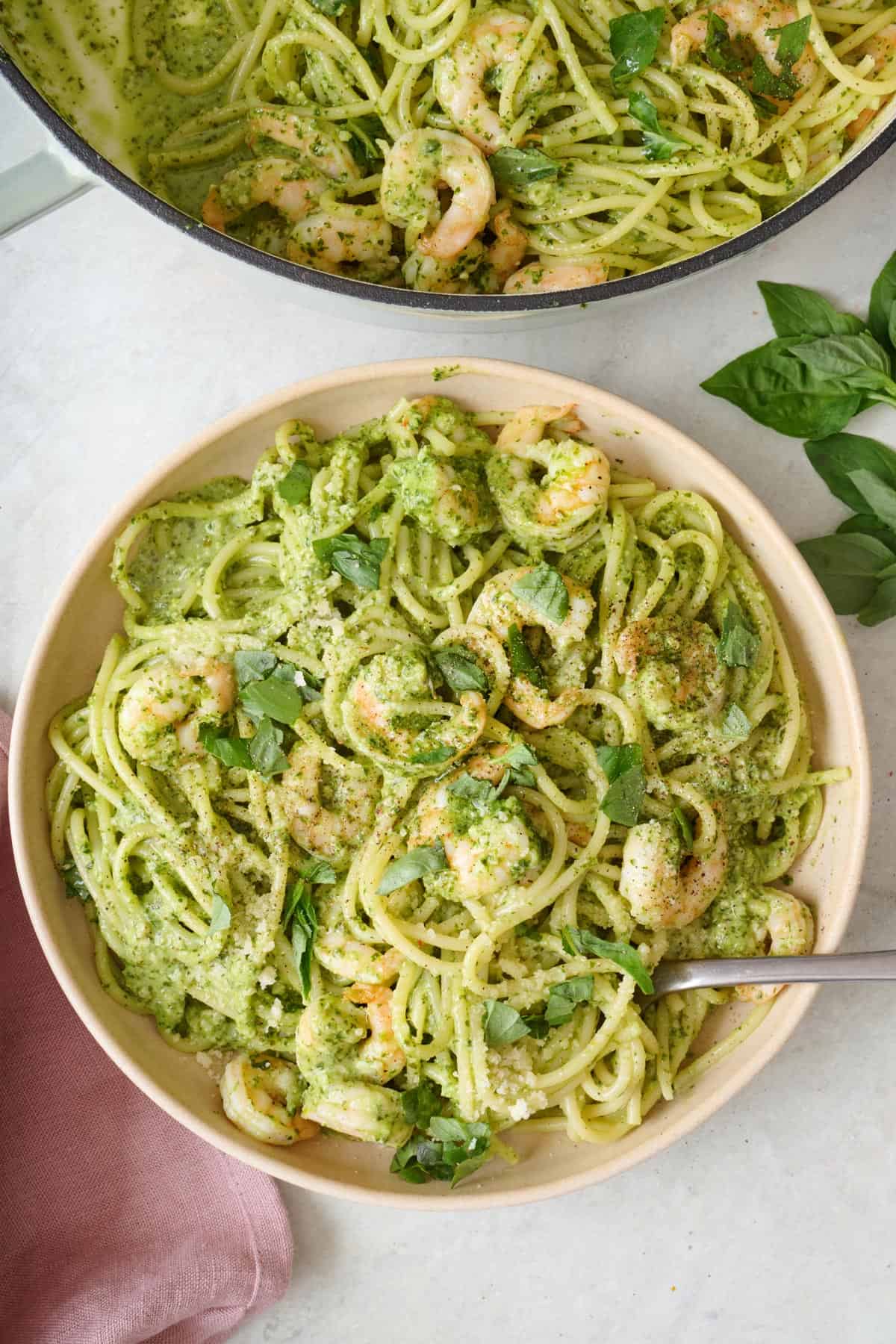
Jump to Section
Recipe At a Glance
Cuisine Inspiration: Italian
Primary Cooking Method: Stovetop
Dietary Info: Pescatarian
Key Flavors: Basil Pesto
Skill Level: Easy
Summary
- Fast to Make: I’m all about quick dinners during the workweek. I can practically make pesto, boil water, and sear shrimp with my eyes closed, and in less than half an hour, we’re sitting down to eat.
- One Pot, One Happy Cook: Just one pot means nearly no mess. It’s such a relief to know that after I indulge in this dish, I’m not facing a mountain of dishes. Plus, I can sneak in a little extra downtime.
- 6 Ingredient Pesto: My pesto sauce uses just six ingredients, and I swap out pine nuts for almonds, which I’m more likely to have on hand. It’s not just easier; I think it tastes better, too.
- Leftovers for the Win: This pasta might be my favorite lunchbox filler for the next day. It reheats well (I do take out the shrimp to reheat), and the flavors mix even more overnight.
Ingredients You’ll Need to Make Shrimp Pesto Pasta

For the Pesto:
- Basil: You can’t beat fresh basil for making pesto! Pick bright and green leaves that remind you of a lush garden.
- Slivered Almonds: I toss almonds into the mix instead of pine nuts. They’re usually right there in my pantry, and they give the pesto flavor and texture.
- Garlic: Nothing beats the zip of fresh garlic. It packs a punch and brings everything to life in the pesto.
- Lemon: A bit of lemon zest and a squeeze of juice add acid and flavor.
- Parmesan Cheese: Freshly grated Parmesan is the way to go. It melts away better than pre-grated and tastes better, too.
For the Shrimp & Pasta:
- Raw Shrimp: Deveined and tail-off for ease and convenience.
- Olive Oil: Simple seasoning to let the shrimp’s natural flavors shine through.
- Spaghetti: Any kind works, but whole grain could add a little extra fiber and nuttiness.
Popular substitutions & additions
- Other proteins. Not a shrimp fan? You can easily use chicken strips, bite-sized steak pieces, or even salmon chunks as an alternative. All these proteins pair wonderfully with the pesto; you’ll just have to adjust the cooking time accordingly.
- Different nuts. If you don’t have almonds on hand, swap them out with walnuts, pine nuts, or even cashews. Each nut will add its own unique flavor to the shrimp and pesto, so feel free to experiment!
- Make it vegan. Opt for vegan Parmesan and use a plant-based protein like tofu or chickpeas instead of shrimp. You still get to enjoy the savory flavors without the animal products.
- Use different types of pasta. Penne, fusilli, or farfalle are all excellent spaghetti substitutes that hold up very well to pesto. If you’re looking to go low-carb, pesto zoodles (zucchini noodles) alone are also a great option!
How to Make the Pesto Sauce
Fun fact, Pesto comes from the Italian word for “pestare” which means to pound or crush. Traditionally, this was done with a mortar and pestle. Now we just use a handy food processor and it’s pesto pronto! Look at that gorgeous green color! I’m obsessed!
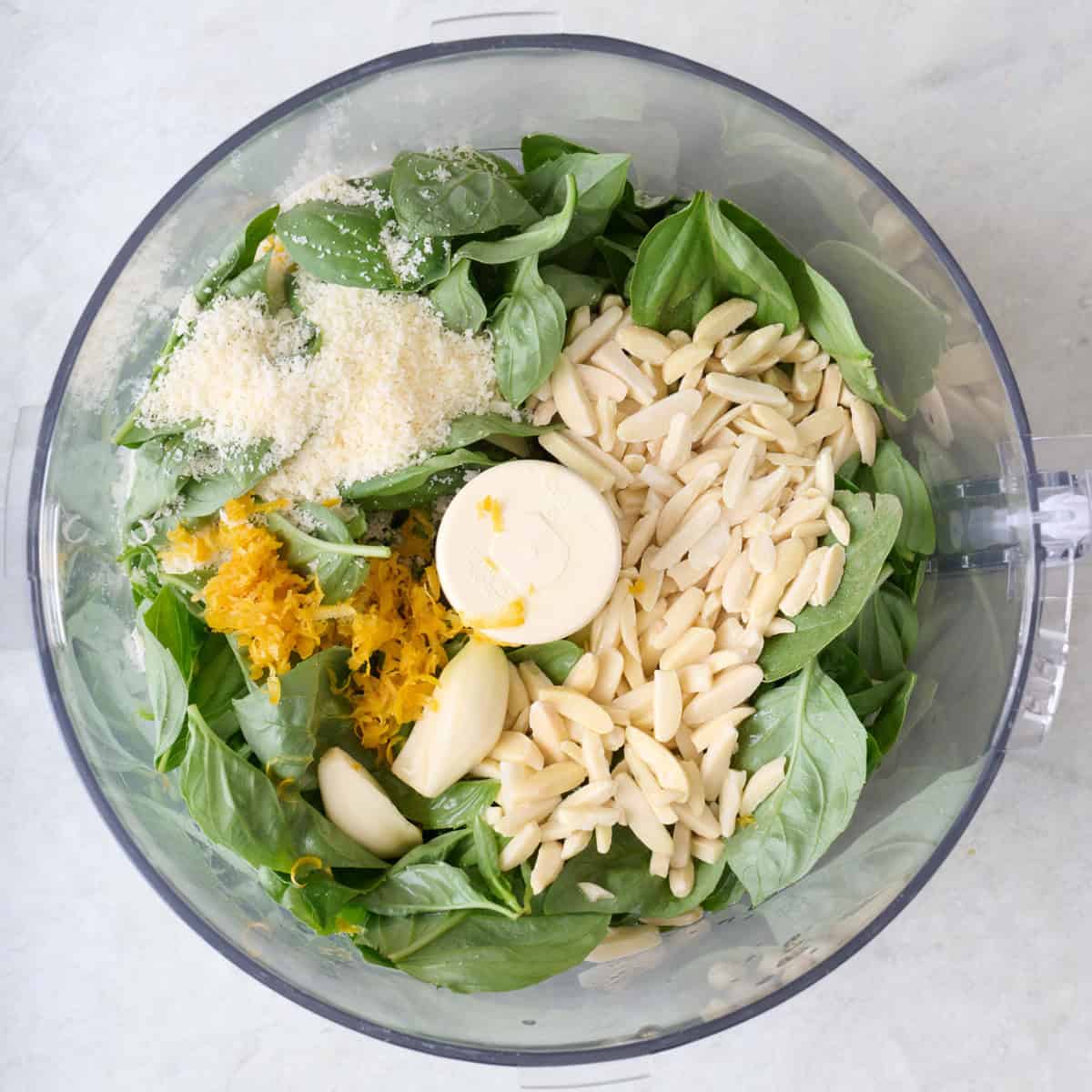
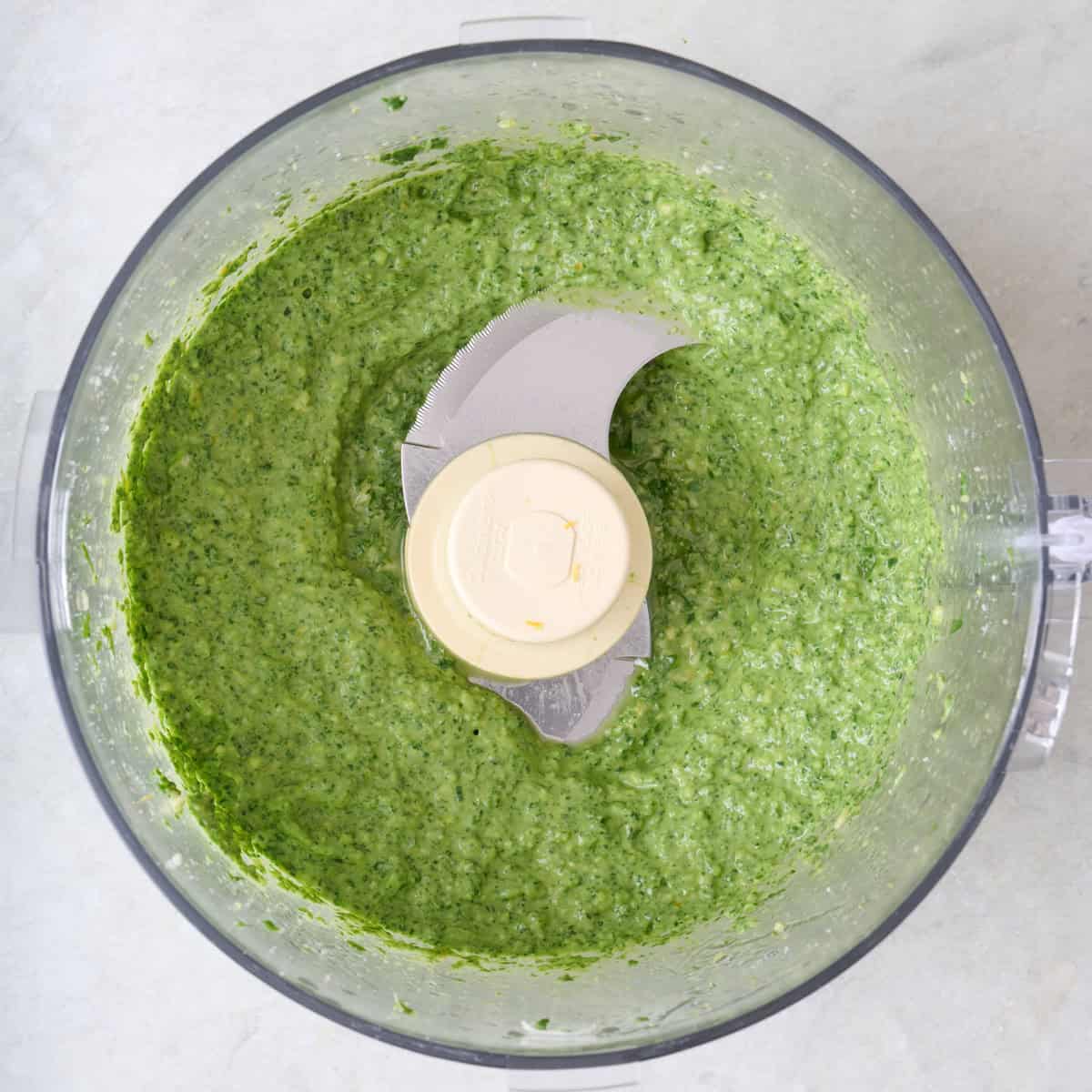
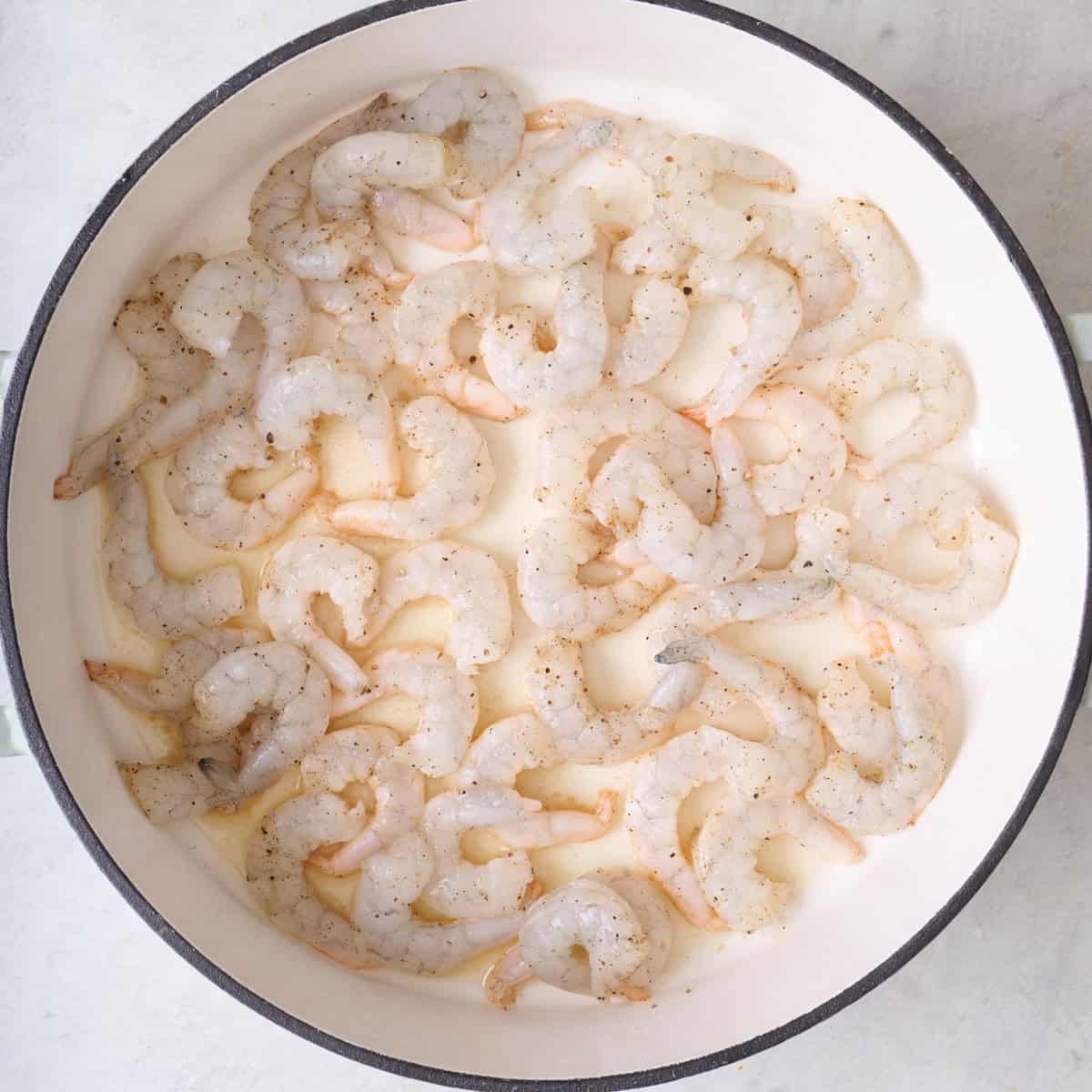
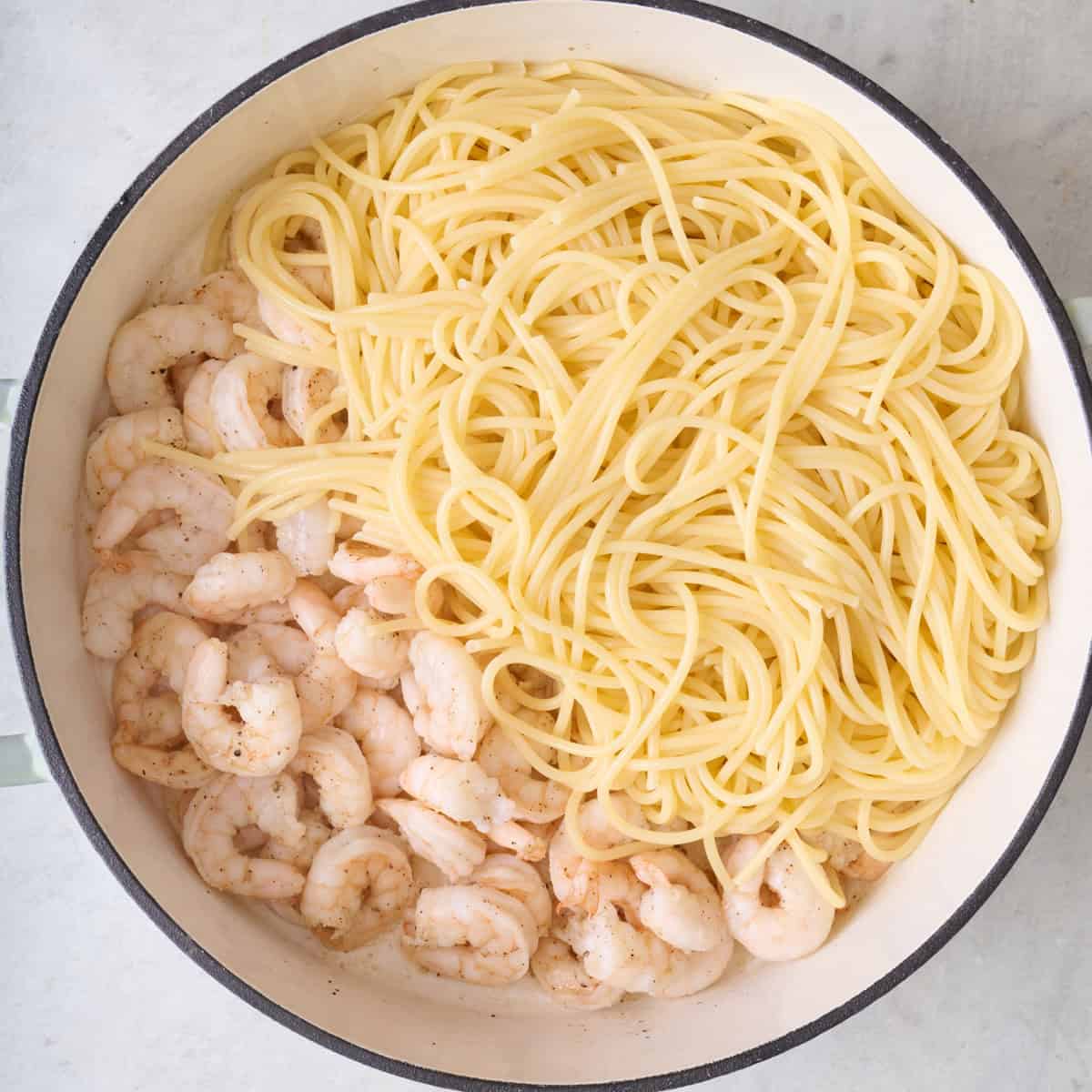


Tips for Making the Best Shrimp Pesto Spaghetti
- Use high quality ingredients as much as possible. Because the ingredients are so simple for the pesto, it all comes down to quality. So you want to make sure to find fresh basil, extra virgin olive oil, freshly squeezed lemon juice and fresh garlic. It will make all the difference in the flavor!
- Use the pulse option on your food processor. Pesto is supposed to be chunky, so feel free to pre-chop the ingredients or use the pulse option of the food processor to chop the herbs roughly before adding the olive oil. This will make sure that the greens keep their bright color and don’t turn pasty with the nuts.
- Reserve pasta water to mix with the pesto. The salty, starchy water left after cooking the pasta adds a lot of flavor to the pesto spaghetti. But an important thing it does in this recipe is actually help bind the pasta and sauce together.
What to Serve With Pesto Pasta
- Olive Oil And Herbs Garlic Bread
- Garlic Knots
- Air Fryer Vegetables
- Fresh Garden Salad
- Classic Caesar Salad with Homemade Dressing
Frequently Asked Questions
Once you’ve made your shrimp pesto pasta, let it cool down to room temperature. Then, transfer it to an airtight container, making sure the lid is secured. This helps keep the freshness in and any fridge odors out. If you have extra pesto, you can store it separately in a smaller airtight container, making sure to cover the surface with a thin layer of olive oil. This oil layer helps preserve the vibrant green color and fresh flavor of the pesto.
To reheat, start by warming the pasta first if you’ve stored the shrimp and pasta separately. Either in the microwave or on the stovetop with a splash of water or broth to prevent drying out. Then, gently reheat the shrimp in a skillet over medium heat until warm but not rubbery, and combine them back together! The pesto will last up to 7 days in the fridge. The pesto spaghetti mixed together will stay fresh for 3-4 days.
Frozen shrimp works perfectly fine! Just make sure to thaw it properly before cooking. Place the frozen shrimp in the fridge overnight, or if you’re in a hurry, you can also run cold water over them until thawed.
Yes, you can! A mortar and pestle will work; it might just take a bit longer. Another option is a blender, though you might need to stop and scrape down the sides more often to get a smooth consistency.
The key is to watch the shrimp closely as they cook. Shrimp cooks quickly, often in just 2-3 minutes per side. As soon as they turn pink and opaque, they’re ready. Avoid leaving them on the heat for too long, and remember they will continue to cook a bit even after you remove them from the heat.

Dive into a plate of this Shrimp Pesto Pasta when you crave something healthy-ish yet simple! It’s a dish that perfectly brings together juicy shrimp with a fresh homemade pesto, a combo that no pasta fan can resist. So good, even the kids at home love it!
For More Pesto Recipes:
- Pasta with Pesto Sauce
- Caprese Pasta Salad with Pesto
- Pesto Chicken Avocado Panini
- Pumpkin Pesto Pasta
For More Pasta Recipes:
- Healthy Shrimp Scampi
- Arrabiata Pasta with Shrimp
- Roasted Red Pepper Pasta
- Pumpkin Pesto Pasta
- Lemon Ricotta Pasta
If you try this feel good Pesto Spaghetti with Shrimp recipe or any other recipe on Feel Good Foodie, then don’t forget to rate the recipe and leave a comment below! It helps others who are thinking of making the recipe. We would love to hear about your experience making it. And if you snapped some shots, share it on Instagram so we can repost on Stories!
This shrimp pesto pasta recipe was originally published on March 16, 2019 and has recently been updated with new photography, step-by-step process shots, tips, and substitutions to better help make the recipe. The recipe has only slightly changed to a more traditional pesto recipe by removing the kale and also using just pasta noodles instead of zucchini noodles. You can find the original recipe in the notes section of the recipe card below.
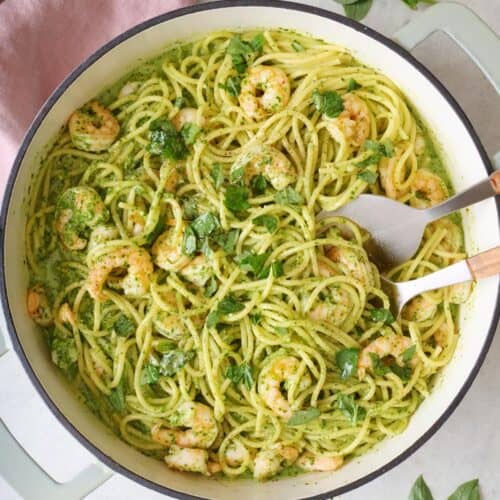
Shrimp Pesto Pasta
Video
Ingredients
For the Pesto
- 3 cups fresh basil leaves destemmed
- ¼ cup slivered almonds
- 2 garlic cloves
- 1 lemon zest and juice
- 2 tablespoons grated Parmesan cheese
- ½ cup extra-virgin olive oil
Instructions
- To make the pesto, in the bowl of a food processor, combine basil, almonds, garlic, lemon zest, lemon juice and Parmesan cheese until finely minced. Then with the machine running, slowly pour in the oil and process until the mixture is smooth. Set aside.
- To cook the spaghetti, bring a large pot of salted water to a boil over high heat. Add the pasta and cook until al dente according to package directions. Reserve 1 cup of pasta cooking water, then drain the pasta and set aside in a colander.
- Place the shrimp in a large bowl and season with salt and pepper. Heat the olive oil in the now empty pasta pot over medium heat. Cook shrimp for 2-3 minutes per side, or until it turns pink and opaque.
- Add the pasta and pasta water on top of the shrimp and stir to combine. Add the pesto and stir until the spaghetti is evenly coated in pesto.
- Divide the pasta among 6 serving bowls.
Notes
- To make the pesto, combine basil, kale, almonds and garlic in a food processor and process until very finely minced. Add the lemon juice and parmesan cheese. Then with the machine running slowly pour in the oil and process until the mixture is smooth.
- To cook the spaghetti, bring a large pot of salted water to a boil over high heat. Add the pasta and cook until al dente according to package directions. Reserve 1 cup of pasta cooking water, then drain the pasta and return to the pot to stay warm.
- To cook the shrimp, season shrimp with salt and pepper. Skewer the shrimp, if desired or as is. Preheat pan to medium-heat and add the olive oil. Cook shrimp for 2-3 minutes per side, or until it turns pink.
- When you’re ready to eat, toss the pesto with the pasta water along with the cooked spaghetti and raw zucchini noodles until well combined. Serve with the cooked shrimp on the side with fresh basil, if desired.
Nutrition
Nutrition information provided is an estimate. It will vary based on cooking method and specific ingredients used.






Comments
Please clarify…the recipe says to combine the pasta, pesto and shrimp, then to divide up into serving bowls and top with 3-4 shrimp. Are these in addition to the shrimp already combined in the pasta/pesto mix? Confused…
You’re right, so sorry about that! The shrimp are meant to be placed/rearranged on the top for serving but the recipe did read confusing, so I updated it. Thanks for pointing this out!
Step 4 says to toss the pesto with the pasta water. Does this mean don’t drain water before adding the pesto? Thanks! Can’t wait to try it.
Hi Laree, no, you do not want to add the pesto to the whole pot of water. The end of step 2 is the instructions for the pasta water. “Reserve 1 cup of pasta cooking water, then drain the pasta and return to the pot to stay warm.” Hope you enjoy!
What spiralizer are you using for the zucchini? I bought the one that attaches to my kitchen aid mixer. It wasn’t pretty! I returned it to the store, immediately.
The one by Paderno World Cuisine! https://amzn.to/3t3SWYc
Yumna, TYVM!
You’re welcome!
If I don’t want to make my pesto from scratch, how much pre-made pesto should I add at the end? Thank you!
Good question! I think it depends on the brand of pesto and your preferences, but I would probably use 1 to 1.5 (7-ounce) containers for each pound of pasta.
When I saw green spaghetti, read the pesto ingredients, could not wait to cook it.
I did. Was super delicious. Thanks for all your healthy meals and snacks recipes.